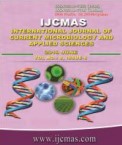


 National Academy of Agricultural Sciences (NAAS)
National Academy of Agricultural Sciences (NAAS)

|
PRINT ISSN : 2319-7692
Online ISSN : 2319-7706 Issues : 12 per year Publisher : Excellent Publishers Email : editorijcmas@gmail.com / submit@ijcmas.com Editor-in-chief: Dr.M.Prakash Index Copernicus ICV 2018: 95.39 NAAS RATING 2020: 5.38 |
Soil biochemical properties are indicators of soil quality, but there is still no consensus as to how they should be used. Generally, biochemical properties related to the biocycles of the elements (C, N, P and S) are used to diagnose soil quality. These properties include both general biochemical parameters (i.e. microbial biomass C, dehydrogenase activity and N mineralization potential) and specific biochemical parameters (i.e. the activity of hydrolytic enzymes, such as phosphatase, Dehydrogenase, urease and b-glucosidase). Soil is a fundamental resource and it is crucial to manage its quality in order to enhance agricultural productivity and environmental quality. Soil enzymes are act as catalyzer in several biochemical reactions which result in the transformation of organic matter release of inorganic nutrients for plant growth and nutrient cycling. Soil enzyme activities are useful biological soil quality indicators since they are operationally practical, very sensitive, integrative, easy to measure more responsive to soil tillage and structure than other soil variables. There are several enzymes in soil, but those involved in hydrolases and the degradation of main litter components are used most often for evaluating soil quality. This paper reviews the roles of soil enzymes such as β-glucosidase, phosphatase and dehydrogenase as well as the implications of their activities for soil quality.
 |
 |
 |
 |
 |